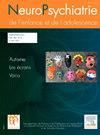Apports des données en vie réelle à la sécurité des antipsychotiques chez l’enfant et l’adolescent
Q4 Medicine
Neuropsychiatrie de l''Enfance et de l''Adolescence
Pub Date : 2025-05-01
DOI:10.1016/j.neurenf.2025.02.002
引用次数: 0
Abstract
The use of antipsychotics (APs) in child and adolescent psychiatry poses major challenges, both in terms of iatrogenesis and drug abuse. Analyzing real-world data from the international pharmacovigilance database (VigiBase®) revealed age-dependent safety profiles with increased reports of alertness disorders, seizures, and aggression in young children, while adolescents were subject to higher rates of depression, abuse, and dependence. Risperidone, aripiprazole, quetiapine, and olanzapine were the most frequently implicated antipsychotics, with olanzapine associated with catatonia and quetiapine notably linked to abuse in adolescents. Nutritional disorders related to antipsychotics were more frequently reported in children and adolescents, with risperidone showing a high disproportionality signal. Adolescents exhibited specific safety concerns, including a signal for non-alcoholic steatohepatitis associated with aripiprazole. Despite the limitations of pharmacovigilance methods, these studies help quantify adverse drug event frequencies in specific subgroups and detect emerging or rare signals. These pharmacoepidemiological analyses emphasize the importance of rigorous, ongoing benefit-risk assessment when prescribing antipsychotics in the pediatric population.
儿童和青少年抗精神病药物安全性的真实数据
在儿童和青少年精神病学中使用抗精神病药物(APs)在医源性和药物滥用方面都提出了重大挑战。通过分析国际药物警戒数据库(VigiBase®)的真实世界数据,揭示了儿童警觉性障碍、癫痫发作和攻击行为的报告与年龄相关的安全性特征,而青少年的抑郁、滥用和依赖率更高。利培酮、阿立哌唑、喹硫平和奥氮平是最常涉及的抗精神病药物,奥氮平与紧张症有关,喹硫平与青少年滥用密切相关。与抗精神病药物相关的营养失调在儿童和青少年中更为常见,利培酮显示出高歧化信号。青少年表现出特定的安全问题,包括阿立哌唑相关的非酒精性脂肪性肝炎的信号。尽管药物警戒方法存在局限性,但这些研究有助于量化特定亚组的药物不良事件频率,并检测新出现的或罕见的信号。这些药物流行病学分析强调了在儿科人群中开抗精神病药物处方时进行严格、持续的获益-风险评估的重要性。
本文章由计算机程序翻译,如有差异,请以英文原文为准。
求助全文
约1分钟内获得全文
求助全文
来源期刊

Neuropsychiatrie de l''Enfance et de l''Adolescence
Medicine-Pediatrics, Perinatology and Child Health
CiteScore
0.60
自引率
0.00%
发文量
61
期刊介绍:
Organ of the Société française de psychiatrie de enfant et de adolescent, Neuropsychiatrie de enfance et de adolescence tackles all fields of child-adolescent psychiatry and offers a link between field and clinical work. As a reference and training tool for students and practitioners, the journal publishes original papers in child psychiatry as well as book reviews and conference reports. Each issue also offers a calendar of the main events dealing with the speciality.
 求助内容:
求助内容: 应助结果提醒方式:
应助结果提醒方式:


